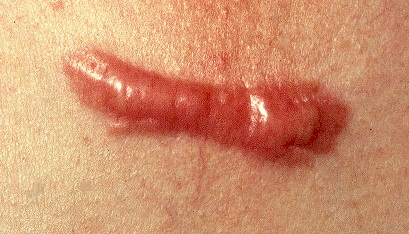You might notice a swollen area which is darker than the rest of your skin area. This is referred as keloid. It may be located in one or several areas of your body. Some people are even less confident wearing certain types of clothes as they might expose their keloid.
What is keloid and how does it occur?
Keloid is a medical term refers to the excessed scar tissues growth during skin healing process after injury. Keloids are commonly the blackened, elevated area over the healed injury. They occur because of imbalance production of collagen protein during wound healing process. They can occur in any skin types, although are experienced more by those people whose dark skin. Hence, keloids are commonly undergone by Afro-Americans, Asians, and Latino. However, there are several things that may contribute to keloids occurrence in certain individual’s skin. Those are:
Keloids are more likely to grow on your back, chest, neck, shoulder, earlobes, and thigh. There are many kinds of injury that can lead into keloids, such as nail-scratched wound, injection wound, bug or insect bites scars, tattoo and piercing wounds, etc. Keloids are usually painless, yet some people find their keloids are reddish, instead of black, and feel stingy or itchy. Young individuals with darker skin are more likely to experience this kind of keloids.
How do you treat keloids?
Although keloids are mostly harmless for your health and do not affect your body in major ways, you might feel uncomfortable if they occur in visible areas. Thus, you start to collect information on how to remove keloids. As the result of imbalance collagen protein release during wound healing, it can take a long time for removing keloids from your body. Some treatments, however, are believed to be able to make it less visible or removed completely. Those are:
- This method sounds cruel and scary, because it uses the method of cutting your keloid out and then leave the rest heal by itself. Some big, bad keloids are reportedly removed by employing this method.
- Steroid injection. In this method, steroid is injected to the keloid area every 2 to 6 weeks. Some steroid injection initially rise the keloid size before it can flat it down. This method is also effective in removing the excess tissues.
- This is the old-fashioned way to remove keloids. Radioactive light is aimed to keloid area to reduce its swell. However, this method is reported to have a side effect of cancers and is no longer recommended to be done frequently.
- Scar removing ointment. This is a simpler, cheaper treatment for keloids. However, it takes quite long time and does not show satisfying effects with big-sized keloids. Despite this, some people find out that massaging your keloid in circular movement while applying the ointment can reduce its size although not its darkened color.
Why does my keloid keep coming back?
Keloids have high reoccurrence possibility. As the result of excessive production of protein collagen, keloids are definitely affected by your body ability to perform this production. To be theoretical, your body should be able to produce sufficient, reasonable amount of collagen in healing any wounds. However, in some cases, your body keeps producing collagen in the exact area previously infected by keloid. Your skin cells keep dividing and form another keloid. This is why it seems to always come back after treatments.One best keloid treatment, although cannot remove it completely is cortisone injection. This is a kind of steroid injection that will make keloids less visible after three-month regular treatments. This treatment has to be done once per month in some consecutive months.
This is quite a logical reason why before you decide to do expensive treatments to remove your keloids, you should rethink. What is the core reason you would like the things to be removed? Is it making any sense? Are you ready for more money and time to do the consecutive required treatments? Because after all, these keloids always have the chances to creep back at any unexpected moment.
